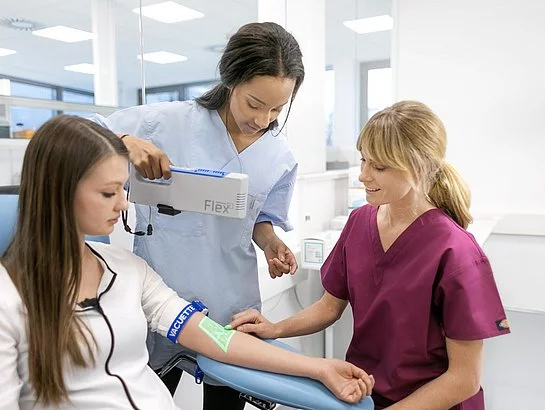Choosing the Right Blood Collection Approach for Children, Parents, and Seniors
Blood collection is a routine medical procedure that provides essential information about a person's health. However, the approach to collecting blood can vary significantly depending on the patient's age, health, and general wellbeing. In this article, we summarize the nuances of choosing the right blood collection approach for children and elderly patients, taking into account factors such as the accessibility of their blood vessels, needle choice, and the potential use of different collection devices.
Children: For your most precious samples
Children often have smaller and more delicate veins, making blood collection a challenging task. It's important to use gentle techniques to minimize discomfort and anxiety, as traumatic experiences early in life may have long-lasting effects. Healthcare workers collecting samples from infants and children need special training, as advised in the WHO Guidelines on Drawing Blood [1].
In addition to adapting the collection system used to the size of the smaller vessels, it may be helpful to use local anaesthetics to ease pain, which should make the process easier.
The following strategies can help reduce stress and anxiety in children, in addition to the standard procedures that must be followed when taking blood [2]:
- Applying verbal communication skills: Use age-specific vocabulary to communicate at the patient’s level
- Patient participation: When possible, giving a patient a role to play, such as “hold the plaster for later” can lessen anxiety by empowering the patient.
- Distractions: Age-appropriate distractions (stimuli) have been shown to minimize stress and anxiety associated with painful medical procedures [3]. Videos, movies, interactive electronic games, use of a vein visualization device, and involvement in counting or singing songs can be used.
- Parents or guardians as coaches: Parental anxiety and stress can have a negative effect on the child’s coping mechanisms. It may be helpful for parents or guardians to participate by contributing coping strategies and direction and by providing positive reassurance.
- Comfort positioning: To help minimize anxiety, it is recommended that children be held by a parent or guardian when possible.
- Performing heel and finger punctures: These methods may be more successful alternatives to venepuncture for paediatric patients, provided that the required tests permit use of capillary blood samples.
More information and recommendations on capillary blood collection in children can be found in our Skin Puncture Manual.
Elderly patients: Navigating aging veins with care
Geriatric patients may have more fragile and less elastic veins, making blood collection more challenging. Limited range of motion can hinder manipulation and make it difficult to locate veins. Other factors may include dehydration and low blood pressure, which can contribute to difficulty in locating veins.[4]
Device selection: In the elderly, the choice of needle gauge becomes critical to minimize trauma to delicate veins. Larger diameter needles should be avoided to prevent collapsing veins. A winged blood collection set, such as the SAFETY Blood Collection Set or VACUETTE® EVOPROTECT SAFETY Blood Collection Set, helps the phlebotomist to access delicate veins with more control, due to the longer tubing for flexibility in positioning and the wings for holding and guiding the needle at a gentler angle.
Vein location: Finding suitable veins may be a challenge due to haematomas from previous venepunctures or ongoing treatment. Be sure to check for potential sites below any bruising and be very gentle.
Tailoring the approach based on the patient's age, health condition, and individual needs is essential for a positive and successful experience. By considering factors such as needle size, collection site, and the use of safety devices, healthcare professionals can ensure that blood collection is not only effective but also minimally invasive, contributing to the overall safety and satisfaction of patients across different age groups.
[1] WHO Guidelines on Drawing Blood: best practices in phlebotomy, 2010
[2] CLSI. Collection of Diagnostic Venous Blood Specimens. 7th ed. CLSI guideline GP41. Wayne, PA: Clinical and Laboratory Standards Institute; 2017, p. 74.
[3] A. BAGNASCO, E. PEZZI, F. ROSA, L. FORNONI*, L. SASSO, (2012), Distraction techniques in children during venipuncture: an Italian experience, J prev med hyg 2012; 53: 44-48
[4] CLSI. Collection of Diagnostic Venous Blood Specimens. 7th ed. CLSI guideline GP41. Wayne, PA: Clinical and Laboratory Standards Institute; 2017, p. 75.
Álljon a biztonság oldalára
Szerezzen meg minden lényeges, világosan bemutatott információt a vérvétel során a biztonságról szóló témában.
A megfelelő kapcsolattartó személy/cím megtalálása a kérelem elküldéséhez
Jogi nyilatkozat
Ez a termékinformáció kizárólag egészségügyi szakembereknek szól. A Greiner Bio-One eszközeit csak megfelelően képzett egészségügyi szakemberek használhatják a vonatkozó használati utasításnak (IFU) megfelelően. A javallatok, ellenjavallatok, óvintézkedések és figyelmeztetések listáját megtekintheti az egyes termékekhez mellékelt használati utasításban, vagy letöltheti a www.gbo.com (Letöltések) weboldalról. További információért forduljon helyi Greiner Bio-One értékesítési képviselőjéhez, vagy látogasson el weboldalunkra.
A gondos feldolgozás ellenére nem vállalunk garanciát a közzétettek vonatkozásában. A Greiner Bio-One GmbH bármely felelősséget, jótállást vagy garanciát ezúton kizár. Minden jog, beleértve a hiba és változtatás jogát is, fenntartva. Egyéb ezzel ellentétes rendelkezés hiányában, a Greiner Bio-One GmbH rendelkezik minden szerzői és/vagy egyéb felhasználói joggal ezen dokumentumokat illetően, különös tekintettel az olyan megjelölésekre, mint az említett (szó-kép) márkajelölések és logók. A Greiner Bio-One GmbH jogainak bármilyen felhasználása, sokszorosítása vagy bármilyen más felhasználása kifejezetten tilos.
Az ezen a blogon megjelenő beszámolók a termékeink és/vagy szolgáltatásaink használatával kapcsolatos egyéni tapasztalatokat közlik. A kiadványban kifejtett vélemények az interjúpartneré; ezek nem a Greiner Bio-One véleményét vagy nézeteit tükrözik.
Ezek az információk részben ügyfeleink véleményét és/vagy egyének tapasztalatait fejezik ki, és nem szándékozik a Greiner Bio-One véleményét vagy nézeteit tükrözni.
Médiatulajdonos és kiadó: Greiner Bio-One GmbH, Bad Haller Str. 32, 4550 Kremsmünster

